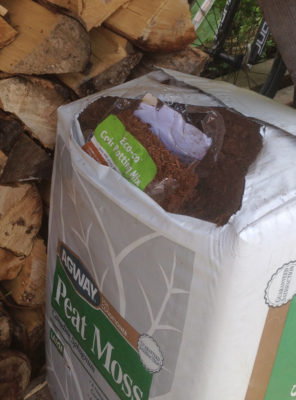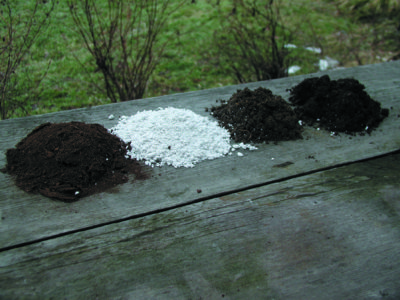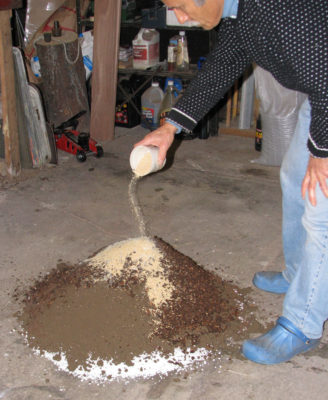MIX POTTING MIX
Coconutty Coir
For a couple of years, a block of coir has sat atop my bale of peat moss.
Peat moss, the product of slow, anaerobic decomposition of organic materials, accumulates, at a snail’s pace, in bogs: an inch or so depth per thousand years. To mine peat, the bog must be first drained. Besides upsetting bogs’ unique ecological habitats, draining the bogs aerates them, sending some of the carbon wafting into the air.
But peat is good stuff for potting mixes. My mixes are made up of equal parts peat moss, soil, compost, and perlite, along with sprinklings of soybean meal (for nitrogen) and kelp (for insurance against lack of any trace elements). Peat’s contribution to the mix is a long-lasting source of organic matter that helps cling to moisture and to nutrients, important in the relative confines of a flower pot.
Coir is marketed as a substitute for peat in potting mixes. A sustainable substitute, made from the fibre left around coconut husks after they’ve been cracked open to remove their meat.
This spring it was time to put that block of coir to the test, with a head to head comparison to peat. (I’ve tried this comparison before, but more casually.) The block, after slurping up a large volume of warm water, was ready to mix with the same ingredients as I mixed with the peat moss.

Some potting soil components
Both mixes went into their separately labelled , 5 gallon buckets. Each mix then was used to fill one-half of a few GrowEase Seed Starter Kits. Into one of the kits went lettuce seedlings, another got tomato seedlings, and a third got pepper seedlings. The 24 cells of each kit are automatically watered via a capillary mat that sits atop a water reservoir, providing very uniform moisture to all cells within a kit and from one kit to the next.
Peat, Coir Standoff
Drum roll . . . and the winner is . . . well, as I recently wrote, some of this year’s seedlings grew very poorly, perhaps, I’ve hypothesized, due to the soil I used, or the compost, both of which vary some from batch to batch. The overcast, cool conditions in the greenhouse during critical growth periods also could be to blame.
Differences in growth between coir and peat based mixes were not great, but tipped slightly in favor of the peat based mix. This, incidentally, jives with my previous, more casual observations. It also jives with more rigorously planned and executed, published research.
Coir Still in the Ring
The results of all this testing don’t spell continued destruction of peat bogs. Coir might still be a viable alternative.
Peat and coir are not the same material. I perhaps should not have used the same ratio for coir as I’ve long used for peat in my mix. There’s some evidence that coir, as it slowly decomposes in a potting mix, can suck up nitrogen at the expense of plants. If so, more soybean meal in my mix could solve that problem. Other nutrients, or lack thereof, could also come into play, as could anti-growth factors, such as phenolics, known to be present in coir.
More playing around is needed with coir.
Peat and Coir Substitutes
No need to put all our eggs in one coir basket. Other organic materials can and have fulfilled the niche of peat (and coir). And our culture has no lack of organic “waste” products. Composted bark has been used in commercial mixes for many years, as has sawdust. More exotic, around here, at least, would be rice hulls.
Home-grown and readily available “organics” for a potting mixes would be compost and leaf mold, both of which I’ve used in rougher mixes, such as for temporarily repotting small trees.
The point is that any of these organic materials, including coir, could make a good potting mix if ratios and amounts of other materials are adjusted accordingly.
Gardening (and farming) should be, and could be, sustainable; even the potting mixes used to raise seedling or grow potted plants.
Now Perlite, Hmmmm
The other major component of any potting mix is some aggregate, for providing good drainage. My mixes use perlite. Not sustainable. More on that another time.



I like your last paragraph under. ” Peat and Coir Substitutes”. I have had good results using only things from our property. We do have chickens and lots of trees and bushes. Because of allowing so much of our place to do its own thing I do get a lot of different plants coming up in my pots. Most I pull some I let go. I understand the need to have a sustainable potting mix and appreciate your effort.
Thanks. Gardening is a balance. It’s not giving Nature free rein. And it’s not fighting Nature.
Do you use these potting mixes for house plants? And do you have a problem with insects showing up in the middle of winter? I have had that happen when I used my compost for indoor houseplant soil mix. Any suggestions on how to both use compost and prevent the wee beasties?
Yes, I use it for houseplants. And yes, sometimes insect do show up. Not a big problem for me.
Do you use this for seed starting as well?
Yes. Except for seed starting I top the mix with 1/2 to 1″ depth of a a 1:1 peat:perlite mix because the latter mix is more assuredly weed free.
Lee,
This is probably not the correct place to post this question but. ..I just bought and read your book. I have two questions: First, for maintenance for a weedless garden, in the fall would i simply re-mulch the pathways and then add compost to the beds? Do you put anything else over composted beds in the spring when you plant or do you just leave the compost itself as the “mulch?” Second, I keep organic meat rabbits. They are over vermicompost bins (well,they used to be vermicompost bins til the “vermi” went south). Anyhow, the rabbits eat fodder and hay. The fodder falls into the bins (along w/ the hay and rabbit manure). It sometimes sprouts. I would imagine you would advise (in this case) to compost this v. adding directly to the garden because those seeds need to decompose. Is this correct?
I do re-compost the beds every year with an inch depth of compost. The paths don’t always get re-mulched annually, but always if soil is becoming exposed. Correct about seeds needing to decompose or killed in hot compost pile.
Lee, I appreciate your observations on peat vs. coconut coir. This spring was my first year attempting seed starting indoors. After research, I used coir and perlite, 3:1, for the seed starting. I don’t have any experience with a peat-containing seed starting mixing, but my feeling was that the seedlings seemed to be stunted and I am wondering if there’s something about the coir that contributed to this. The seedlings did fine up until their first true leaves came in and then really slowed down. When the true leaves came in, I potted them up in coir, compost, and perlite 3:1:1. I watered them with a diluted fish emulsion and also some diluted Yum Yum Grow Mix tea. So, I am not exactly sure what it is, but maybe the coconut coir was to blame. I hate to be using something unsustainably sourced like peat but felt like I spent a lot of time on these seedlings, just to end up either buying some starts from the store or watching these still stunted plants that are now transplanted into my garden.
The coir-perlite mix has virtually no nutrients for plants. (Same goes for peat-perlite.) No nutrients results in stunted growth.
I have tried using coir for seedling mix in the past, and I had disappointing results. As you say, there are no nutrients in it at all. I also found that it drys out
pretty quickly, which is the kiss of death for young seedlings. I am using perlite now, with better success. This year I am also hydrating big block of coir and mixing them into my raised box beds to see how that affects plant growth. The soil always melts down after a season and I have to top them anyway. I usually add loam and compost, but this year I am adding the coir and compost to plump the beds. Lo and behold, I have had to feed plants in those beds with ProGro Organic. Here in Maine, many people have had trouble with seedlings. My tomato plants are positively sulking. Please post something about your plums this year, if you can. We had terrible temperature swings up here and many people lost the early forming fruits.
Why not top your beds each years with just compost, if you have enough. One inch depth will supply all the nutrients plants need for a year so you won’t have to even fertilize. Great plums this year. I guess the flower buds were just right to miss the late freeze. Looking forward to a bountiful harvest soon, which is not all that common here.
Instead of an either/or, can the two be combined to use as the base to add the other ingredients to? Any challenges to the two playing nicely together?
Raise the soybean meal, and reduce dolomitic lime according to proportions of mix? (50/50; 60/40)
If you mean the coir and peat, I don’t see why not? I’m not sure what you mean by your second paragraph.
Thanks Lee, and apologies for the 2nd. Like walking through a dark room, I’m still working through understanding how all the components of a mix work together and do what. Assuming the dolomitic lime is simply to adjust the pH of the peat, if there were no issues with blending the two I’d just have to remember to adjust the lime/soybean meal according to how they’re mixed (60% peat 40% coir blend, add less lime and more soybean meal to keep the mix in balance)
I think that seems right except for: why more soybean meal?
Again apologies as that was an assumption based on a speculation. In the article you mentioned coir might consume more nitrogen as it broke down, so my thought was that if more coir is used in the peat/coir mix then less lime but more soybean meal to offset the nitrogen loss. (at least that’s my thinking)
Also, I wondered what methods you use to eliminate/counteract the phenolics you mention as being present in coir.
What you wrote about extra nitrogen and less lime makes sense. I should try it, although it would be hard to judge how much extra of one and less of the other. Looking over some of the published literature about coir, one of the main concerns is that the product is variable. The pH might be 5 or it might be 6. It also frequently holds more water than peat, and N immobilization may or may not be a problem. Probably the best route would be to get coir from a specific source then adjust pH, nitrogen, and watering, as needed for mixes made with that coir. Sorry to be so unspecific.
No apology needed, Lee, thank you for taking the time and giving the additional information. I was working under the impression coir was pH neutral so to find out that’s not the case, helps a lot, as well as how it retains water, I think I’ll make up a 1/2 dozen trial recipes to see which one produces the best results… also probably need to invest in a decent pH meter.
Thank you again, Lee.
Please do report what you find. And remember that coir characteristics could vary from manufacturer to manufacturer. (hopefully not from batch to batch from a particular manufacturer.)
I certainly will, Lee. And thanks for the reminder. I was tempted to buy the coir blocks from a wholesaler off of Craigslist, but was concerned about salt levels associated with coir and didn’t want to risk it, so spent a little more to get them at an area farm/garden center: https://hydrofarm.com/p/JSCCM25 hopefully with their experience/track-record, they’ve minimized those variables.
Several years ago, I used coir in a potting mix a lot for planting vegetables in pots. The first year, when the coir was freshly mixed, the plants were a little slow and didn’t excel, however, in the second year, the coir had broken down and become more soil-like and anything I planted in that mix resulted in healthy, productive vegetables. If you were able to add moisture and a few other ingredients, e.g. manure, worm castings, etc. to help break it down, it will become more plant friendly. It really needs to be aged IMHO.
Thanks. I might try that. That should be included in “instructions for use”, on the packaging if it is, in fact, the case.
I meant to add – let it sit unused for some time – possibly six months to break down and neutralise whatever it is in coir that inhibits growth in plants.